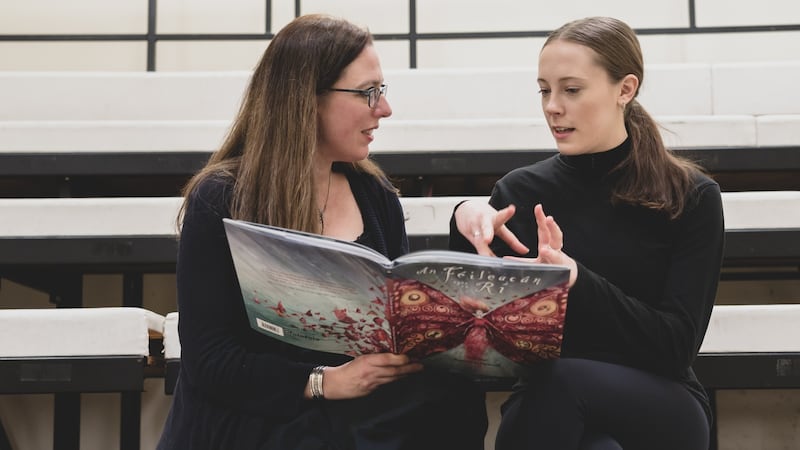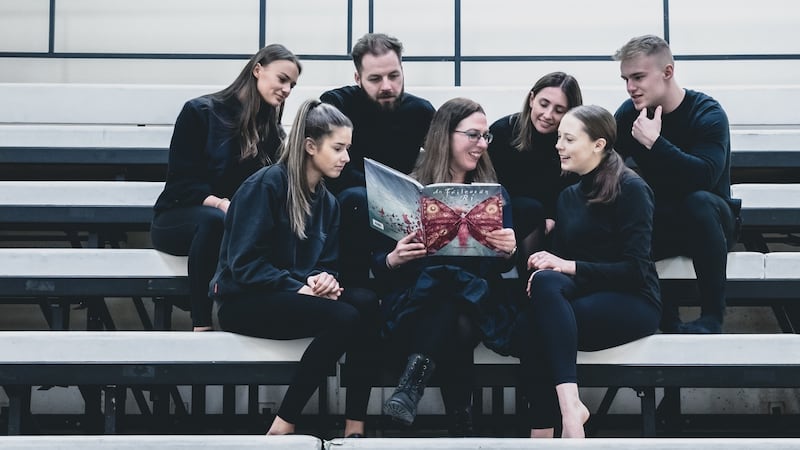“Please come and see our show! Did I say show? I meant our hearts and souls laid bare in dance and words and pictures. We hope you will love it as much as we do.”
A recent Tweet by children's author Máire Zepf conveys keen anticipation of a new Irish/contemporary dance adaptation of her latest book An Féileacán agus an Rí (The Butterfly and the King), which will be premiered at An Cultúrlann in west Belfast during this year's Belfast Children's Festival.
Zepf – until recently the inaugural Children's Writing Fellow at Queen's University's Seamus Heaney Centre for Poetry – has developed a strong simpatico with her creative partner, 23 year-old dance maker Clara Kerr.
Her updating of the ancient Irish myth of Mídhir and Étaoin, illuminated by glorious illustrations by Waterford-based artist Shona Shirley MacDonald, is as much a gift to a choreographer as to a reader.

"To be given a story that is so beautiful makes my job much easier", says Kerr, a graduate of Liverpool Institute for Performing Arts and two-times Northern Ireland champion in festival Irish dance.
“It is told in chronological order and the pages and illustrations create the scenes. Máire will be reading the story between the dance segments, blending the words with the movements.
“The connection to Irish heritage is very important to me because I have so much Irish dance in my background. It just felt right.”
The two were brought together by Holywood Shared Town, a charity run by volunteers, which organises a variety of community and cultural activities in the County Down town where they grew up and still live.
The premiere will coincide with the Northern Ireland launch of the book and the 20th anniversary of the Aisling School of Irish Dance in Holywood, from which the ensemble of seven young dancers is drawn.
The school's director is Denise Catney, a former pupil of the late Patricia Mulholland, whose distinctive style of folk-ballet lives on in Irish dance circles. Catney and Zepf are old friends. During a conversation in a local ice cream shop, they reflected on the large number of creative people living in the town and mulled over the idea of some kind of collaboration involving words and dance.

Meanwhile, Kerr, who has taken classes with Catney since she was four, was already choreographing a piece called Chrysalis as the school’s entry in the 2020 Northern Ireland Championships for Festival Irish Dance. As if by serendipity, the butterfly motif was very much in the air.
Zepf was raised in an Irish-speaking family. Her father is a retired doctor and university lecturer, her mother a retired occupational therapist with an art and music background.
“We spoke only Irish at home but all my schooling was in English”, she says. “We were considered rare creatures. There were doomsayers who would warn my parents that their children would never be able to speak English. Our friends used to refer to our house as Narnia – the sun was shining everywhere but it was always snowing inside the Blaneys’ house!
There's a complete lack of agency for this female character. When you revisit some of these old tales, you feel there's something uncomfortable about them.
“My mum’s side of the family is very much about the aural storytelling tradition. She would tell us stories from her childhood, kind of organic storytelling, whereas Daddy is all about the books and the preciousness of the artefact itself.”
When Zepf and her siblings were young, Irish language children’s books were thin on the ground but that presented no problem within their household.
" My dad would take books that we had in English and translate them. If there was something that we needed and it didn't exist, like a poster or a game, he would make it or invent it. He was completely devoted to the language. He used to knock on the doors of elderly people around the Gaeltacht in Donegal with his notebook, collecting words."
She studied medieval history at Oxford and worked as an account manager – “a suit” – in an advertising agency in London before moving back to start her own family.

While living in Germany with her then-husband and children, she began posting humorous accounts of housebound motherhood on Facebook, as an outlet for her slumberous creative juices. They were spotted in Ireland by the editor of the journal An tUltach, who invited her to write a regular column called In Ainm na Máther (In the Name of the Mother). It was at this point that she declares herself to have been bitten by the writing bug.
Her first book, a historical fiction for children about Titanic, was published in 2012, the centenary year of the disaster. A string of historical fictions and picture books followed, the most successful of which, Ná Gabh ar Scoil! (Don’t Go To School!) has been translated into seven languages and was nominated as the 2015 Children’s Book of the Year in Ireland.
The idea for an updated version of An Féileacán agus an Rí came from her publisher Futa Fata. It is the first in a series of old tales retold by different authors and, as it happened, was a story she remembers from her childhood.
“It goes back many eras”, she explains. “It’s written down in the oldest existing Irish manuscript, the 12th century Book of the Dun Cow, but in the aural tradition it goes back to the 8th or 9th centuries, when it was called Tochmarc Étaíne (The Wooing of Étain).
“It’s a stunning story, with the transformation of a young girl into a butterfly. And it’s a story of lost love and how two young lovers get back together in spite of the obstacles they face.
“The editor asked me to look at how it sits with modern values, particularly in terms of gender. It is and always has been Éadaoin’s story but, in the old versions, she’s bought and sold and bewitched and finally won in a game of chess. There’s a complete lack of agency for this female character. When you revisit some of these old tales, you feel there’s something uncomfortable about them.
The contemporary dance style is soft and makes a nice, flowing contrast with the more structured nature of the Irish dance
“It was a daunting task because the story is very precious to me. In rejigging and restitching it, I went back to the original and took it all apart, picking out the iconic moments that needed to stay intact. I can see now how it could adapt well to dance and I am so fascinated to see what Clara has done with it”.

Kerr, who recently won a three-month scholarship to the Broadway Dance Centre in New York, has invited onto the project three fellow LIPA graduates, two from England and one from Norway. She will dance the dual roles of Éadaoin and the butterfly.
“I try to keep up my Irish dancing by performing or teaching or competing when I come home,” she says. “I am always threatening to give it up, because it takes such a toll on your body, but then it pulls me back in because I love it so much.
“The fusion aspect of the piece is an exciting challenge. From Shona’s wonderful illustrations I got a real sense of movement, with the winds and all that swirling energy.
“Éadaoin is a powerful young woman and the chess motif is very strong. She plays for her own freedom, as opposed to men playing to possess her. Chess is an intellectual concept but it offers so many physical opportunities, with the dancers weaving in and out of each other like pieces on a board.
“The contemporary dance style is soft and makes a nice, flowing contrast with the more structured nature of the Irish dance. When Éadaoin becomes a butterfly, there will be a noticeable change in her, with fluttering arms and frantic movements as she finds herself trapped in another form. The combination of the two should be very strong and moving and I am hoping they will mesh well with Máire’s beautiful writing.”
An Féileacán agus an Rí is at Culturlann McAdam Ó Fiaích on March 7th and 8th.
The 22nd Belfast Children's Festival runs from March 6th to 11th.











